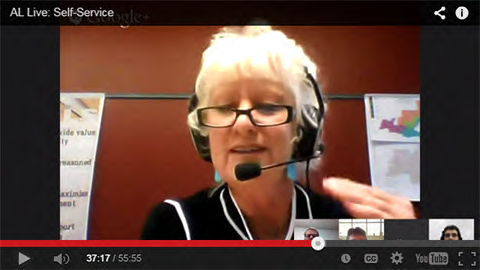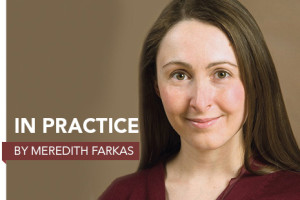
Self-service software and devices were the focal point of the September 18 episode of American Libraries Live (AL Live). Panelists Karen McPheeters, director, Farmington (N.Mex.) Public Library; Mary Johns, director, Siouxland Libraries in Sioux Falls, South Dakota; and Matt Bellamy of 3M (which sponsored the episode) answered questions from moderator Dan Freeman, eLearning manager for ALA Editions/ALA TechSource, on how they use self-service technology in their libraries.
McPheeters noted that the world in general has made a shift toward self-service, from checking out at the grocery store to libraries. Johns echoed this idea, suggesting that resistance to self-service technology is more of an issue internally than with patrons.
When self-service debuted in libraries more than a decade ago, library staff members were afraid for their jobs, Johns explained. Once it became clear that while job descriptions would change but no one would lose their job, it was easier to get staffers on board. The technology just made processes more efficient and allowed the trained staff members to utilize more of their talents in the library.
“I’d rather pay someone to use their personal skills than stand at a piece of equipment and check in books,” she said.
Bellamy acknowledged that 3M sees libraries as a growing market for their products. “Libraries are busy places so any efficiency they can add is helpful,” he said.
McPheeters agreed, saying “Moving into self-check environment got people out from behind the desk and got to do the fun part of our job.” She added that converting to self-service is really an opportunity for teaching and engaging with. While helping them with a self-checkout machine, the librarian could also talk about programming, for example.
Panelists urged library administrators to carefully consider whether their organizations were ready to make significant changes before switching to self-service. Johns encouraged staffers to see it as an opportunity review their policies and ask “Why are we doing this?”
“We always talk about change in a negative way, but we actually increase our credibility with customers because they see us keeping up,” Johns said.
Relevance was a main goal for McPheeters and her library when converting to self-service. “We want to stay relevant. We want to be the first choice,” she said, adding that everything at their library changed for the better as a result. “A little interaction at the self-check machine changed the whole dynamic between staff and patrons.”
When vetting new technology, McPheeters said one of the first things she looks for is intuitiveness. “Four-year-olds can use the self-checkout machines!” she said.
Bellamy said that 3M designs machines with accessibility in mind, from visual and heading disabilities to language barriers. Panelists agreed that libraries of all sizes would benefit from self-service.
“Self-service gives you more control over what you’ve got,” McPheeters said. “We’re doing the basic things better, and it frees up time to do other things like makerspaces and programming.”
Panelists also encouraged a team mentality when going through any transition by communicating with staff members and making sure everyone understands why changes are being implemented. “Convert staff to an idea. It makes it easier to teach patrons if you’re using technology yourself,” McPheeters said.
Johns added that many staffers are very tech-savvy, and encouraged librarians to recognize and utilize the expertise of their colleagues.
McPheeters stressed that librarians are influencers in the community, especially as new technologies show no sign of slowing down. “We are very powerful. We can teach other people how to change. This is the world we live in. It’s going to change. There will be something new coming down the road,” she said. “Staff has the ability to change patron behavior by modeling it. And it worked.”
Johns said that her library’s efficiency, credibility, and customer service have all improved as a result of implementing self-service. “We’re delivering a much higher quality level of service,” she said. “Libraries have a vital role to play in communities, so the more time we can dedicate to those things, the better. Some benefits may be hard to quantify—but they make a difference in people’s lives.”


